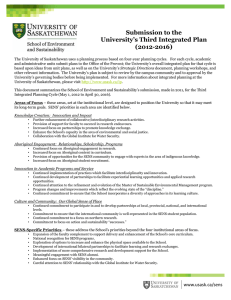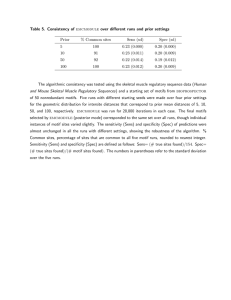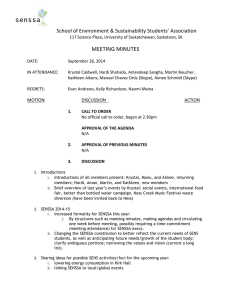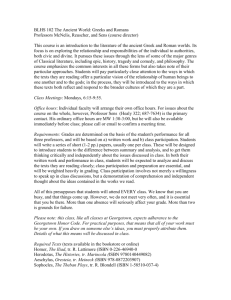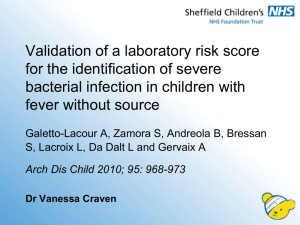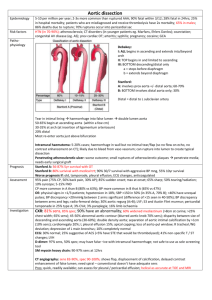RESPONSE TO SENS EXTERNAL REVIEW REPORT
advertisement
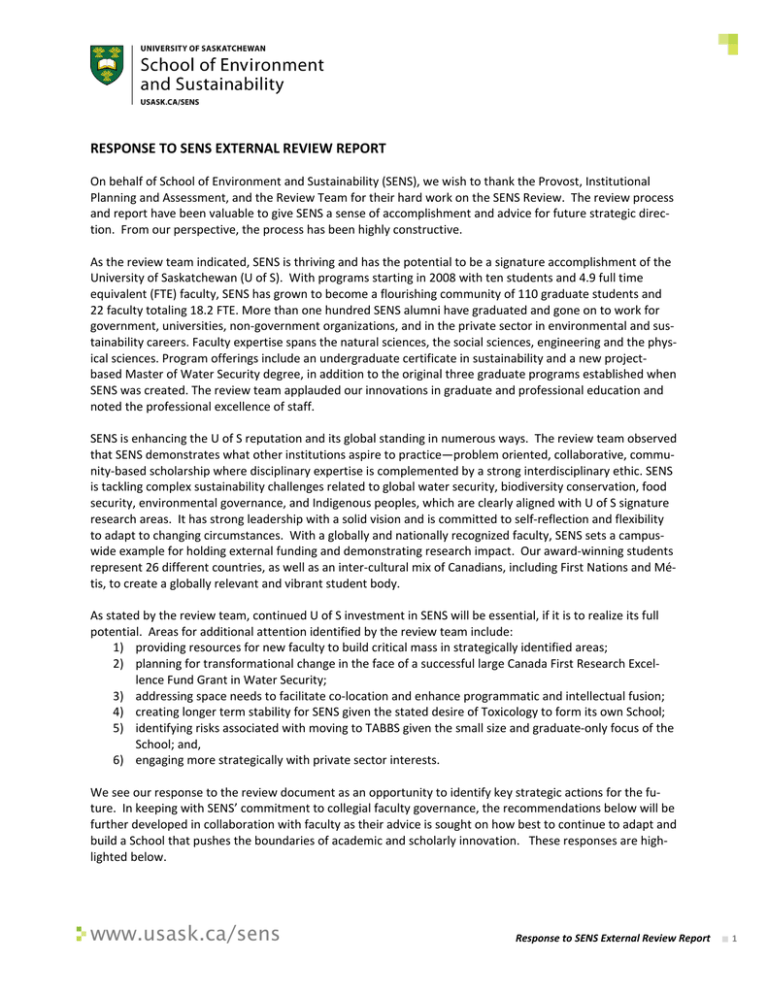
RESPONSE TO SENS EXTERNAL REVIEW REPORT On behalf of School of Environment and Sustainability (SENS), we wish to thank the Provost, Institutional Planning and Assessment, and the Review Team for their hard work on the SENS Review. The review process and report have been valuable to give SENS a sense of accomplishment and advice for future strategic direction. From our perspective, the process has been highly constructive. As the review team indicated, SENS is thriving and has the potential to be a signature accomplishment of the University of Saskatchewan (U of S). With programs starting in 2008 with ten students and 4.9 full time equivalent (FTE) faculty, SENS has grown to become a flourishing community of 110 graduate students and 22 faculty totaling 18.2 FTE. More than one hundred SENS alumni have graduated and gone on to work for government, universities, non-government organizations, and in the private sector in environmental and sustainability careers. Faculty expertise spans the natural sciences, the social sciences, engineering and the physical sciences. Program offerings include an undergraduate certificate in sustainability and a new projectbased Master of Water Security degree, in addition to the original three graduate programs established when SENS was created. The review team applauded our innovations in graduate and professional education and noted the professional excellence of staff. SENS is enhancing the U of S reputation and its global standing in numerous ways. The review team observed that SENS demonstrates what other institutions aspire to practice—problem oriented, collaborative, community-based scholarship where disciplinary expertise is complemented by a strong interdisciplinary ethic. SENS is tackling complex sustainability challenges related to global water security, biodiversity conservation, food security, environmental governance, and Indigenous peoples, which are clearly aligned with U of S signature research areas. It has strong leadership with a solid vision and is committed to self-reflection and flexibility to adapt to changing circumstances. With a globally and nationally recognized faculty, SENS sets a campuswide example for holding external funding and demonstrating research impact. Our award-winning students represent 26 different countries, as well as an inter-cultural mix of Canadians, including First Nations and Métis, to create a globally relevant and vibrant student body. As stated by the review team, continued U of S investment in SENS will be essential, if it is to realize its full potential. Areas for additional attention identified by the review team include: 1) providing resources for new faculty to build critical mass in strategically identified areas; 2) planning for transformational change in the face of a successful large Canada First Research Excellence Fund Grant in Water Security; 3) addressing space needs to facilitate co-location and enhance programmatic and intellectual fusion; 4) creating longer term stability for SENS given the stated desire of Toxicology to form its own School; 5) identifying risks associated with moving to TABBS given the small size and graduate-only focus of the School; and, 6) engaging more strategically with private sector interests. We see our response to the review document as an opportunity to identify key strategic actions for the future. In keeping with SENS’ commitment to collegial faculty governance, the recommendations below will be further developed in collaboration with faculty as their advice is sought on how best to continue to adapt and build a School that pushes the boundaries of academic and scholarly innovation. These responses are highlighted below. www.usask.ca/sens Response to SENS External Review Report 1 Organizational Structure and Governance Key actions: 1) Build critical mass in strategic substantive areas 2) Maintain a faculty of the whole 3) Create long term stability 4) Experiment with flexible governance structures 5) Reward secondary joint appointments 6) Cultivate leadership and succession planning SENS is evolving based on the original U of S vision for the new schools, emerging funding opportunities (e.g., GIWS), and experimentation and systematic self-reflection. The review team raised important questions related to how to build and balance critical mass in our key areas (water security, sustaining ecosystems, and sustaining communities) with existing resources on campus and potential new hires. A sound governance structure will be needed should new units be incorporated, allowing for semi-autonomous co-existence, while maintaining accountability, focus and flexibility. SENS places high priority on maintaining a faculty of the whole—a unified group that can support the problem-oriented, interdisciplinary mission that defines SENS. All faculty participate in decision-making and collective governance. This is in contrast to the culture of silos that predominates at the U of S (e.g., 17 colleges and schools with nearly 500 degree programs; roughly twice as many programs as other comparable universities). SENS’ culture of integration is predicated on acknowledging that disciplinary, as well as interdisciplinary, expertise is essential to our success. This includes reciprocal deference for all disciplines; respect for different intellectual frames, ways of knowing and outputs; and a collective willingness to think of the common good of the School. These features make SENS unique. A faculty of the whole is essential to avoid fragmentation along disciplinary or functional lines, which would be detrimental to how we function as an integrated unit. Commitment to active collegial life that maintains the faculty of the whole is expected of all who are affiliated with SENS. The biggest threat to the School is the stated desire to turn the Toxicology program into its own school with the intention of moving joint SENS/Toxicology faculty into that new school. This would significantly weaken SENS’ sustaining ecosystems research focus, would weaken the ties of key faculty members (Drs. Karsten Liber, Markus Hecker, Tim Jardine and Paul Jones) to SENS and would reduce the scope of key research projects that involve other SENS faculty. We agree with the review committee that a clear position needs to be taken by the Provost and U of S leadership about whether Toxicology will be allowed to form its own school/department. A key question is whether a governance structure could be found to accommodate moving Toxicology into SENS. The review panel noted that to build critical mass in SENS, the School should seek additional opportunities to add faculty or other units where this makes strategic sense. A potential model for semi-autonomous functionality may be emerging with the development of the new Master in Water Security (MWS) degree. While oversight for this program ultimately rests with the Executive Director and existing SENS governance structures, significant discretion has been given to the MWS advisory committee. As an interdisciplinary school, SENS must continue to cultivate respect for other disciplines, nurture cross-cultural competencies to understand other disciplines, and give discretion to colleagues with the appropriate expertise in their respective substantive areas so that we can function as a faculty of the whole. Advancing this culture is essential to the sound practice of problem-oriented knowledge creation in the service of society. As has been quipped, Response to SENS External Review Report 2 “the world has problems, but universities have departments” and we need to be wary of falling into the counter-productive tendency to create departments and silos. Flexible governance structures will be essential to allow SENS to maintain a faculty of the whole while incorporating new programs, faculty and units. Secondary-joint appointments are a very important component of SENS’ success to date. The review panel indicated that SENS has interdisciplinary appeal for our secondary-joint appointments, as well as graduate student support in the form of scholarships, funding for student travel, and a higher rate of overhead return than some home departments. Yet, secondary-joint appointees may not have been sufficiently recognized or rewarded for their commitments to SENS. SENS should investigate additional ways to support its secondaryjoint appointees and provide an incentive for them to continue to participate in SENS’ activities should they elect to maintain their joint status. The institution also needs to investigate options for allowing greater SENS input into performance and merit review in the home units of joint appointees. Leadership succession remains a concern within SENS, as the School is comprised of relatively junior faculty and a small number of senior faculty with multiple responsibilities. In another 2-3 years, several faculty will proceed to the ranks of tenured associate or full professors and it will be imperative to find paths to cultivate leadership out of this maturing cohort. Leadership development opportunities within SENS and outside of SENS will be important. In the meantime, SENS will need to develop Assistant Directors Research and Academic to ensure sufficient coverage of key administrative duties. Research Key actions: 1) Identify signature problem areas with a sustainability nexus 2) Refine substantive depth in key research areas 3) Develop critical mass of faculty in signature problem and research areas 4) Plan for a successful Canada First Research Excellence Fund proposal and the transformational impact it could have on SENS While SENS has a research identity that can be communicated easily to external audiences and has resonance within the School, the key areas of sustaining ecosystems, sustaining communities and water security do not convey great substantive depth. SENS needs to focus on big issues that connect to global sustainability issues. Given the national and provincial demographic trends related to Indigenous populations, continued focus on Indigenous topics and working with Indigenous peoples will be important. The provincial focus and comparative advantage of agriculture suggests the need for the School to identify some clearer ties to the College of Agriculture and Bioresources and the Global Institute for Food Security. A process by which each focal area begins to identify where the depth of scholarship lies, its nexus with sustainability, and how it might be greater developed over time would be helpful. Identifying key hires in each area could help prioritize resources and future development of the School. On the horizon is the potential for the GIWS to secure a Canada First Research Excellence Fund Grant in water security ($120 million) that could have significant positive outcomes and present major challenges for the School. Existing concerns about imbalances among the three research areas (water security, sustaining ecosystems and sustaining communities) would be exacerbated by a successful grant. Nonetheless, an influx of resources could also help build greater ties among the different areas, should faculty be prepared to take advantage of such a momentous accomplishment. For instance: how could the sustaining ecosystems and sustaining communities areas support water security, should the Canada First Research Excellence Fund water proposal be successful? This would not necessitate all faculty serving the water security focal area, but Response to SENS External Review Report 3 would rather take the form of identifying areas of overlap and mutual interest to build in strategically beneficial ways. Should the Canada First Research Excellence Fund Letter of Intent be successful, beginning to plan now for how to constructively embrace this opportunity will be essential. Additional faculty hires should be possible out of this grant and the highest priority would be quantitative social scientists, including an economist, who could strengthen ties between the water security faculty and the sustaining communities faculty. Critical mass was identified by the review committee as an area deserving attention. When SENS is compared to national and international aspirational peers, we are significantly smaller in terms of total faculty. The review panel recognizes our need to grow strategically, although it is not clear that SENS will be able to afford new positions, given that it does not offer undergraduate courses and the TABBS-based system might be biased against smaller, graduate-only units. The review committee identified several potential paths for SENS to add faculty, including additional joint appointments, especially at the associate or full professor rank. Significant overlap between SENS and the Department of Geography and Planning was identified by the review team. Opportunity may exist to combine faculty and leverage graduate and undergraduate opportunities given the respective strengths of each unit. Mutual gain will be important for each unit if strategic alliances are sought. Academic and Educational Activities Key actions: 1) Engage in more proactive acculturation processes to cultivate success for international students 2) Continue to experiment with novel ways to create community among faculty, students and staff 3) Pursue a new building that could co-locate all SENS faculty and students 4) Contract with a marketing consultant to develop a student recruitment plan for North American markets The current trend of growing international student enrolments indicates that SENS needs to think more strategically about how to acculturate students from diverse backgrounds and academic traditions. Establishing clear expectations for performance in how we practice scholarship in SENS will be important. Dr. MJ Barrett’s course on Professional Integrity and Generous Scholarship in 2015 was an initial step to create a proactive response to this challenge. It may be helpful to have the SENS Academic Programs Committee identify other strategies. Continuous attention to how we create community within SENS will be important given that faculty and students are not co-located. New efforts with faculty, including an off-site, two-day writing retreat in April 2016, will attempt to co-locate everyone, albeit temporarily. Ice cream socials, lunches, retreats, team teaching, speed networking for faculty research, and regular faculty meetings are some of the other efforts that have been tried. The renovation of the student lounge will hopefully create a more attractive gathering place for students to meet and interact. Co-locating all faculty in SENS would significantly enhance the School’s collaborative capacity. As the review panel noted, it is counterproductive to locate SENS faculty in three very different locations. The review panel recommended that a joint facility serving all three units of the School would be the single most important step to building future integration. We agree and would like to pursue the possibility of a new building at the southeast corner of Innovation Boulevard and Resources Row. The configuration of such a space will require deep consideration given the need of some faculty for access to specialized laboratory facilities. Response to SENS External Review Report 4 Student recruitment is a concern, especially for the professional programs—Master of Sustainability and Environmental Management and Master of Water Security. Targeted marketing in Saskatoon and throughout Saskatchewan is needed to fully leverage the comparative benefit and value offered by SENS’ proximity and excellence. Entrance scholarships for highly qualified MSEM candidates could also help boost enrolments. Contracting to develop a local marketing plan could help identify nearby markets in the United States. Mission and Vision Key actions: 1) Identify how SENS incorporates sustainability into its teaching and research 2) Revisit the commitment of SENS faculty to the concept of sustainability 3) Accept that there will never be one universally accepted definition of interdisciplinarity for SENS faculty Interdisciplinarity was identified as an area where we do not have agreement among faculty on concept and definition. It is unlikely that we will ever have a singular, unified vision of interdisciplinarity within SENS. This is evolving for each faculty member, in terms of how they understand it and practice it, and for the School as a whole. The broader point is that we embrace the value of interdisciplinary work and practice it. Sustainability was identified as a distinctive feature within the School, but the review team had a hard time identifying how we were practicing this more concretely. Moving forward, SENS will need to better articulate what we mean by sustainability (e.g. the importance of economic, environmental and social pillars; integrating diverse disciplines in problem- and solution-oriented ways; a community-based focus; transdisciplinarity) in our teaching, research and outreach. Sustainability is infused in our graduate attributes (“deeply understand sustainability”), our course work (ENVS 806: Field Skills in Environment and Sustainability, ENVS 807: Sustainability in Theory and Practice, ENVS 808: Tools and Application for Sustainability Problem-Solving, ENVS 809: PhD Seminar in Environment and Sustainability, and ENVS 992: Project in Environment and Sustainability), but is perhaps less evident in our research. While two of our research focal areas are explicitly labeled as “sustaining ecosystems” and “sustaining communities,” it is not clear how we are practicing sustainability related to these areas. The same could be said for the water security area. A more explicit discussion of what we mean by sustainability in these areas and how we practice it (or not) will be useful. Partnerships Key actions: 1) Maintain the existing partnership with the Redberry Lake Biosphere Reserve 2) Pursue additional partnerships with the private sector 3) Create an external advisory committee SENS will need to continue to pursue active partnerships both on and off campus. The value of the partnership with Redberry Lake Biosphere Reserve was noted favorably by the reviewers. Other partnerships, such as with Beardy’s and Okemasis First Nation and the Northern Village of Cumberland House, are emerging. Noticeably absent from current partnerships is the private sector. A strategic plan for how to engage with industry will be needed. Research chairs in strategic areas such as energy, water and agriculture are potential possibilities. An external advisory committee for SENS could be helpful in guiding this process and providing advice in how to proceed without jeopardizing the moral mission of the School. These, and other options will be explored with faculty. Response to SENS External Review Report 5
